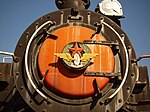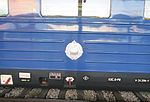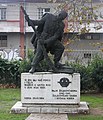Yugoslav Railways
shipping | |
| Predecessor | |
|---|---|
| Founded | 11 November 1918 |
| Defunct | 27 April 1992 |
| Fate | Breakup of Yugoslavia |
| Successor |
|
| Headquarters | services |
Yugoslav Railways (Croatian: Jugoslavenske željeznice; Serbian: Jugoslovenske železnice, Југословенске железнице; Macedonian: Југословенски железници, romanized: Jugoslovenski železnici; Slovene: Jugoslovanske železnice), with standard acronym JŽ (ЈЖ in Cyrillic), was the state railway company of Yugoslavia, operational from the 1920s to the 1990s, with its final incarnation transferring to Serbia. The successor of JŽ is the joint stock company of the Serbian Railways in 2006.
History

The company was first founded as the National Railways of the
As Yugoslavia underwent occupation and partition by Axis powers during 1941, Yugoslav State Railways ceased to exist and its rolling stock was divided between Deutsche Reichsbahn (DRB), Hungarian State Railways (MÁV), Bulgarian State Railways (BDŽ), Ferrovie dello Stato Italiane (FS) and the two new railway companies that were created to serve Independent State of Croatia and Nedić's Serbia: Croatian State Railways (HDŽ) and Serbian State Railways (SDŽ), respectively. By the end of the Second World War, the railways suffered considerable destruction and only with great effort was it re-established after the war. Many locomotives were returned, changed or handed over as reparations to Yugoslavia. With the handover of the eastern territory of Trieste to Yugoslavia, about 100 km of railway network with one-way current (3 kV) became part of JDŽ. In 1952 it was renamed Yugoslav Railways (JŽ).
In the 1950s work began on the construction of the Montenegrin section of
At the beginning of the
Upgrades
During its existence, Yugoslav Railways upgraded a number of older lines and integrated many others.
- Following Nikšić-Podgoricawas completed in 1948, with 760 mm (2 ft 5+15⁄16 in) gauge.
- A single-track electrified line connecting Prešnica with Koper was built in 1967.
- In 1965, the Nikšić-Podgorica corridor was upgraded to standard gauge, thus standardizing the entire connection from Bar to Nikšić via Podgorica. The section from Nikšić to Bileća was decommissioned at the time, as well as the Gabela-Zelenika line.
- A large 760 mm better source needed] Today that connection is severed.[citation needed]
Successor companies
- Željeznica Crne Gore (ŽCG) - Montenegro
- Hrvatske željeznice (HŽ) - Croatia
- Željeznice Federacije Bosne i Hercegovine (ŽFBiH) - Federation of Bosnia and Herzegovina, Bosnia and Herzegovina
- Željeznice Republike Srpske (ŽRS) - Republika Srpska, Bosnia and Herzegovina
- Makedonski Železnici (MŽ) - Macedonia
- Slovenske železnice (SŽ) - Slovenia
- Železnice Srbije (ŽS) - Serbia
- Hekurudhat e Kosovës- Kosovo
Yugoslav Railwaymen's Day
Yugoslav Railwaymen's Day on
Rolling stock
In its beginnings, the JŽ used mostly Austrian and Hungarian-made steam locomotives.[citation needed] Electric and diesel locomotives were introduced in number from the 1960s onwards; electric locomotives were acquired from Ansaldo (Italy); Alsthom, ASEA also supplied some classes, and locomotives were also license-built in Croatia and at Electroputere in Romania; in the 1980s the indigenous AC electric JŽ series 442 was developed by Rade Končar.[6]
Most of the mainline diesel locomotives were from
Railcars, EMUs, and DMUs were sourced from Spain, Italy, Hungary, Germany and the Soviet Union from a variety of manufacturers.[6]
Classification system
A new numbering system was tried for the new standard locomotives built from 1930. All locomotives were renumbered by 1935, which was valid for steam engines.
The locomotives on the 760 mm (2 ft 5+15⁄16 in)
A three-plus-three digit class designation system was used from the late 1950s - the first digit indicated the power type of vehicle: 0, 1 and 2 were reserved for steam traction, 3 indicated 3 kV DC traction; 4 25 kV AC traction; 5 multisystem traction (not used until the
Locomotives and railcar classes
Carriages
Both carriages from the former Yugoslav Railways, as well as second-hand carriages from all over Europe, are available, however many of them not in operating condition. At the moment, all locomotive-hauled passenger trains use former SJ coaches and, in the case of the InterCity, one carriage of Makedonski Železnici.
| Description | Image | Type | Number | Built | Builder | Notes |
|---|---|---|---|---|---|---|
| ÖBB-Spantenwagen | Former ÖBB Spantenwagen
Acquired around 1984. At least one seen 50 72 24-20 650-2 | |||||
| Built in Yugoslavia. One seen with UIC 50 72 24-25 508-7 |
Gallery
-
Former logos of Yugoslav railways
-
Former logo of Yugoslav railways
-
Former Blue train of Tito
-
Monument dedicated to anti-fascist railway workers of Rijeka, Croatia during WWII
References
- ^ "A SHORT HISTORY OF THE RAILWAYS IN DALMATIA 1876-2007". Archived from the original on 7 October 2008. Retrieved 31 May 2010.
- ^ "Dubrovnik to Sarajevo in 1965 by Charlie Lewis". Penmorfa.com. Retrieved 31 May 2010.
- ^ "From Sarajevo to Dubrovnik in 1967 by Dave Sallery - Page 1". Penmorfa.com. Retrieved 31 May 2010.
- ^ "Vozni red vlakova". Archived from the original on March 13, 2016.
- ^ Ignjatović, Srećko (9 April 2014). Generalni štrajk željezničara Jugoslavije 15. aprila 1920. godine (PDF). Sarajevo. Retrieved 8 February 2023.
{{cite book}}: CS1 maint: location missing publisher (link) - ^ a b c d Theo Stolz; Christophe Stolz (eds.), "Die Aufteilung des JŽ-Triebfahrzeugparkes", www.le-rail.ch (in German)
- ISBN 91-7266-012-0.
External links
- Frank Válóczy (ed.), Railways of the former Yugoslavia, archived from the original on 26 October 2009
- Winchester, Clarence, ed. (1936), "In central Europe", Railway Wonders of the World, pp. 1454–1463 illustrated description of the railways of Yugoslavia in the 1930s.




